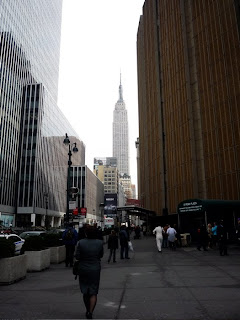Pack Arts Journalism in the Age of Un-Art: Writing About the Whitney Biennial
 Though I have yet to see the newly-opened Whitney Biennial, I enjoy my biennial hobby of reading all the reviews before I go. I'm always looking to test my thesis that something I call "pack arts criticism" is at work. I'll explain. "Pack journalism" is a term often used to characterize the tendency of political journalists to cover a story with a single mindset, and I think arts journalism works the same way. Within days of the opening of any Biennial, I start to see a consensus building among the critics, often lead by critics at the major news outlets. The critical reception of the 2008 Whitney Biennial, which opened yesterday, is shaping up in a similar way.
Though I have yet to see the newly-opened Whitney Biennial, I enjoy my biennial hobby of reading all the reviews before I go. I'm always looking to test my thesis that something I call "pack arts criticism" is at work. I'll explain. "Pack journalism" is a term often used to characterize the tendency of political journalists to cover a story with a single mindset, and I think arts journalism works the same way. Within days of the opening of any Biennial, I start to see a consensus building among the critics, often lead by critics at the major news outlets. The critical reception of the 2008 Whitney Biennial, which opened yesterday, is shaping up in a similar way.Holland Cotter, in today's review of the Whitney Biennial for The New York Times connects the exhibition with an economy in recession. He characterizes the Biennial, with its "uncharismatic surfaces, complicated back stories," as an "unglamorous, even prosaic affair." Later in the review, he describes the biennial as a "hermetic, uningratiating show." Now that Cotter has set this tone, I'm watching other critics who are less sure of their art critical skills to follow his un-lead.
David Cohen and Alexandra Peers joined Cotter in setting the tone for future critics, penning early reviews, for their respective media outlets. Cohen, in his review at the New York Sun, prefers "anti" over "un" for his evaluation. He writes of the Biennial, "Instead, it is simply the lack of formal cohesion that suffices as the deflationary, antiheroic, anti-Art-with-a-big-A statement for most of these artists." Peers, writing about the opening for New York Magazine, veers toward the word "unfinished." She writes of the less-than-enthusiastic response, "The dominant aesthetic was so tentative and half-done that one rival institution’s curator wondered if artists racing to make deadlines hadn’t finished."
The curators set the tone themselves. Shamim M. Momin and Henriette Huldisch pitched the themes of un-ness in their conceptualization for the exhibit. Time Magazine's Richard Lacayo asked them their thoughts while organizing the show, especially what Huldisch terms as "lessness," a theme on which she elaborates more in the catalogue. In a blog post for Time, Huldisch defined "lessness" for Lucayo as follows: "One is a tendency towards non-spectable, non-monumentalism. I talk about three different directions. One is failure as a key motif. Another is an inclination to use modest, humble materials. And lastly there's this notion of people making smaller, more localized gestures that have an 'in the moment' aspect."
Well. Talk about lowering expectations. And she sure knows how to make up words. "Lessness" is the title of a Samuel Beckett story, but that's about the extent of its use as a real word, as far as I know. "Non-spectable" is also a non-starter. If the curator is arguing, and she may be, that the Whitney Biennial is less than spectacular, without any "spectable" attraction and in which failure is certainly an option, then I'm not too surprised that critics seem to be searching for an artist here and there about whose work there would be something nice to say.
Following the high-profile opening of "Unmonumental" (not a real word either), the inaugural exhibit at the New Museum, the Whitney has ushered in The Age of "Whatever." These early reviews, all restrained and tentative and probably more polite than they wanted, will likely set the tone for others over the next few weeks. In summation: Here's the Whitney Biennial. Come see it or not. Whatever.
Image: Photo of a chair in a gutter in Tribeca, an un-art artifact by Walking Off the Big Apple. March 2008.
See related posts: Best Chance to Get Into the Whitney Biennial? Don't Turn 40 and More on the 2008 Whitney Biennial Selections: The Global M.F.A.





Comments
Post a Comment